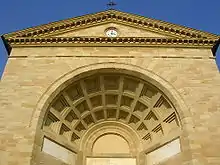Giuseppe Puini
Giuseppe Puini (21 July 1806 – 9 August 1869)[1] was an Italian engineer and architect who worked in the neoclassical style in Tuscany, largely at Livorno, where he was largely responsible for the piazza that provides an urbanistic setting of the Cisternone (1842) and the Church of Sant’Andrea, and for the Church of San Giuseppe (illustration).

At Florence he planned in 1854 the extension of the Lung'arno embankment leading downstream to the Cascine, which he published as Sudi e progetto del Lungarno di Firenze nel punto più interessante alle Cascine, (Florence, 1854).[2] He designed the small tower on the Oltrarno (left) bank at the end of the medieval walls.
He was born at Regello, near Florence, the son of Valentino Puini. He gained his degree of Master of Architecture at the Accademia di Belle Arti Firenze, 1828. He died in Florence, 1869, and is buried in the Protestant Cemetery, called the "English" cemetery, in Piazzale Donatello.
His only familiar work in architecture, the church of San Giuseppe, Livorno (detail) was completed in 1839-42. The facade with its trompe-l'œil niche with a coffered barrel vault, refers to the Cisternone nearby.
Notes
- Dates from his tombstone in the Protestant Cemetery, Florence (on-line register Archived 2007-10-25 at the Wayback Machine).
- Advertised in Scritti per fanciulli: uniti alle Letture di famiglia (Tipografia Galilejana, Florence), 7 April 1854: p 717.